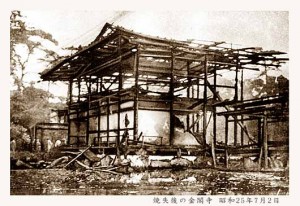Explore Japan – Kinkakuji Temple in Kyoto Japan Posted by keiko on Dec 16, 2013 in Culture
Have you ever seen any temple covered with gold leaf? Well, one of the most well recognized temples in Japan, Kinkakuji (kinkaku ji, 金閣寺) is actually a special temple that is covered with pure gold leaf, and it is also called, “Temple of the Golden Pavilion.” This temple is located in Kyoto, Japan and is designated as a National Special Historic Site and a National Special Landscape site among one of the 17 locations comprising the Historic Monuments of Ancient Kyoto under UNESCO World Heritage Site. Let me introduce you this popular temple in this article. Its history is very interesting, actually the temple that exists today is not an original one. Unfortunately, it was burned down once and was reconstructed back in 1955.
Kinkakuji(kinkaku ji, 金閣寺) is located in the north part of Kyoto, Japan. The formal name is actually, “Rokuonji, (rokuonji,鹿苑寺 )”. In 1397, it was built by Yoshimitsu Ashikaga, who was the 3rd shogun of the Ashikaga shogunate who ruled from 1368 to 1394 during the Muromachi period of Japan. It was built as a villa originally, but after Yoshimitsu passed away, the Rokuonji was transformed into a Zen temple. Since the top two stories of the pavilion are covered with pure gold leaf, it became knows as “Kinkakuji (kinkaku ji, 金閣寺). “Kin,金” means gold, “Kaku, 閣” means pavilion, and “Ji,寺” means temple in Japanese.
Kinkakuji(kinkaku ji, 金閣寺)has 3 floors, and it incorporates different architectural style in each floor beautifully. The style used on the first floor is “Shinden style(shin-den, 寝殿造り ) , also knows as “The Chamber of Dharma Waters”. It reflects the reminiscent of the residential style of the 11th century Heian imperial aristocracy. The style used on the second floor is “Buke style (buke,武家造), which is also known as “The Tower of Sound Waves”, which is a warrior style. The third floor is traditional Zen style and called “Zenshu Yoshiki(zen-shu yo-shiki, 禅宗様式).
I mentioned above that Kinkakuji(kinkaku ji, 金閣寺) was once burned down. Well, that happened on July 2, 1950, by a 22-year-old novice monk, whose name was Yoken Hayashi (yoken hayashi, 林承賢). There are many documented reasons as to why he committed the arson, but most of them are related to his mental and health reasons. It is documented that he had a sever stammering symptom, and also he was not mentally stable. He attempted to commit suicide afterwards but he was taken into custody and survived. He died of tuberculosis in 1956. The pavilion was restored in 1955 after the fire damage.
Photo from Wikipedia.com
Enjoy the following short video that shows Kinkakuji(kinkaku ji, 金閣寺) covered in snow. It looks absolutely amazing!
Lastly, below is a cool site where you can see the Kinkakuji(kinkaku ji, 金閣寺) in LIVE! The image is updated every 3 minutes between 5 am and 8 pm, Japan time.
http://www.shokoku-ji.jp/k_live.html
Hope you enjoyed learning another aspect of Japan!

Build vocabulary, practice pronunciation, and more with Transparent Language Online. Available anytime, anywhere, on any device.





Comments:
Chuck McCrossan:
I visited this temple on November 5th this year. It is so beautiful along with the surrounding grounds. I took many photos on my trip. I’m not sure if you could see them unless you become my Facebook friend. Check and see.
Chuck
keiko:
@Chuck McCrossan Hi Chuck,
Wow, I can imagine how beautiful the Kinkakuji was in the fall over there. I have to check out your photos!
Marc:
This temple is wonderful. Omamori of kinkaku-ji can be found on http://www.omamori.com